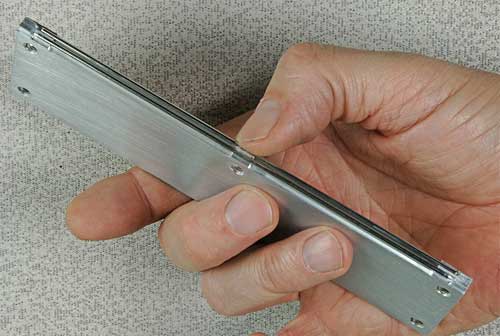SASS® 4100
Two-Stage Aerosol Concentrator Operational Details
How Does the Two-stage Collector Work?
The SASS 4100 is a direct offshoot of our highly successful SASS 4000 aerosol concentrator. In both devices, 4000 liters/minute of ambient air is continuously sampled as a primary air stream. Particulates in this air stream are transferred to a much smaller secondary air stream using patent-pending centrifugal and virtual impaction principles.
Particles are routed into the secondary flow by forcing primary circuit air to circulate through specially shaped channels where centrifugal force and particle momentum isolate and concentrate the particles. The interior structure has been designed so that the smallest flow cross-section is a channel 0.6 mm wide x 6.35 cm long, providing good resistance to clogging by larger particles. A coarse screened cover with 5.4 mm square openings further restricts the entrance of large debris.
The secondary flow can reach aerosol concentrations that are 4X to 15X higher than present in the incoming air, yet the velocity of this secondary aerosol concentrate flow is much lower than peak velocities in the primary circuit. The two-stage sampler therefore amplifies and slows down the captured ambient aerosol particles prior to their collection.
This aerosol concentrate is collected by directing the secondary air through an electret bulk filter media; devoid of particles, the secondary air is re-introduced into the primary air flow (see Figure 1). Due to advantageous pressure differentials within the device, one prime mover fan drives both the primary and secondary flows.
This dry sampling method has several favorable attributes:
- The primary fan rotor is the only moving part.
- Maintenance is minimal.
- The operating temperature range is very wide.
- The structure is comparatively clog resistant.
- Sampled air volume is maximized, improving collection statistics.
- Organism viability is maximized by using low air flow velocities and a bulk electret filter media

Air Flow Patterns
Airflow patterns are shown schematically in Figure 2. Air flows radially inward into the concentrator through the coarse square-mesh screen previously mentioned. This inward radial flow provides 360 degree sampling of the surrounding aerosol environment. A quick-release tripod that is standard with the product allows the circumferential sampling section to be located from about 0.6m to 1.43m above the tripod mounting surface.

The primary fan and a curved air shroud are mounted above the sampler inlet section, channeling exhaust air into a vertical stream away from the inlet area. The electret filter is mounted in a compact, easily disengaged holder located under the device’s baseplate, shown in the inset of Figure 2.
Collection Blades
The particulate concentration process is primarily performed within 20 rectangular collection ‘blades’ that slip into radial slots in the main structure (Figure 3). These blades are precisely formed to the desired shape using state-of-the-art CNC machining centers at Research International. This manufacturing method assures that air moves as intended within the interior channels and minimizes particle loss through wall collisions, while also minimizing the overall pressure difference required to push air through the device.

Collection Filter
The disposable capture element is a 43.4 mm O.D. x 3 mm thick micro-fibrous filter ultrasonically bonded to a circular frame of 59 mm diameter and 5 mm thickness. The fibrous media is up to 50X more efficient than a conventional glass or cellulosic material because each fiber incorporates a built-in electric field that captures particles using electrostatic dust precipitator principles – but at a microscopic level. This ‘electret’ media is stable to 70°C, is virtually inert, and has high holding capacity due to a large internal surface-to-volume ratio.
Performance
Figure 4 shows typical data of sampler collection efficiency as a function of particle size. The collection efficiency is alternatively given as an ‘enhancement factor’ and as an equivalent secondary flow rate. That is, the actual secondary flowrate is about 265 LPM, but due to the concentrating nature of the two-stage sampler, it behaves as if the second stage were operating at a larger airflow.

For example, at a particle diameter of 1 micron, the enhancement factor is 5X. This means that the sampler is operating as if it had 100% efficiency at an airflow of 5 x 265 = 1325 LPM. Alternatively, since the primary airflow in these tests was about 3600 LPM, that the absolute collection efficiency for the concentrator and filter together is 100 x 1325/3600 = 37%. For larger particles, an absolute collection efficiency of about 58% of the particles in the 3600 LPM airflow can be expected, or an enhancement of about 8X relative to the actual secondary flow of 265 LPM. This Figure is based on tests that used polystyrene microspheres (density=1.05 g/cc) and fragments thereof, as test particles. Collection rates were determined from multiple test runs using a Met One 200L laser particle counter.
Acoustic Behavior
It is difficult if not impossible to process large quantities of air without there being an accompanying acoustic output. The SASS 4100 creates a 72 dB-acoustic signature at 1 meter, measured at the midplane of the concentrator section.


